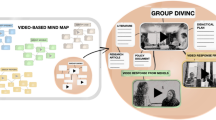Abstract
Group work projects are common components of graduate course curricula. Instructors often try to mitigate the benefits of group work projects for students while avoiding negative effects. Informal learning and participatory culture practices like video logs can enhance learning environments. Video logs that promote both informal learning and participatory culture practices have captured the interest of researchers as a popular way to disclose observations, reflections and thoughts about people’s lives and experiences. This study provides insight on how graduate students may respond to participation in a Collaborative Video Logs (CVL) in lieu of group work projects or asynchronous text-based discussion boards. A CVL is a series of videos created by a small group of students addressing a topic and engages students through asynchronous video conversation while promoting ownership, reflection, and academic and social outcomes. This study summarizes students’ past experiences and perceptions of group work projects, technological readiness, and affective responses to participating in a CVL as a course assignment.
Similar content being viewed by others
References
Alden, J. (2011). Assessment of individual student performance in online team projects. Journal of Asynchronous Learning Networks, 15(3), 5–20.
Burgess, J., & Green, J. (2009). YouTube: Online video and participatory culture. Cambridge: Polity Press.
Cameron, B. A., Morgan, K., Williams, K. C., & Kostelecky, K. L. (2009). Group projects: student perceptions of the relationship between social tasks and a sense of community in online group work. American Journal of Distance Education, 23(1), 20–33. doi:10.1080/08923640802664466.
Carini, R. M., Hayek, J. C., Kuh, G. D., Kennedy, J. M., & Ouimet, J. A. (2003). College student responses to web and paper surveys: does mode matter? Research in Higher Education, 44(1), 1–19.
Cayari, C. (2015). Participatory culture and informal music learning through video creation in the curriculum. International Journal of Community Music, 8(1), 41–57.
Cayari, C., & Fox, H. L. (2013). The pedagogical implications of the collaborative video log. 2013 Annual Proceedings: On the Practice of Educational Communications and Technology, Association for Educational Communications and Technology, 351–363.
Dommeyer, C. J. (2012). A new strategy for dealing with social loafers on the group project: the segment manager method. Journal of Marketing Education, 34(2), 113–127. doi:10.1177/0273475312450384.
Hung, S. (2011). Pedagogical applications of vlogs: an investigation into ESP learners’ perceptions. British Journal of Educational Technology, 42(5), 736–746. doi:10.1111/j.1467-8535.2010.01086.x.
Isaac, M. L. (2012). “I hate group work!” Social loafers, indignant peers, and the drama of the classroom. English Journal, 101(4), 83–89.
Jackson, B., & Wallin, J. (2009). Rediscovering the “back-and-forthness” of rhetoric in the age of YouTube. College Composition and Communication, 61(2), 374–396.
Jenkins, H., Ford, S., & Green, J. (2013). Spreadable media: Creating value and meaning in a networked culture. New York, NY: NYU Press.
Jensen, M., Mattheis, A., & Johnson, B. (2012). Using student learning and development outcomes to evaluate a first-year undergraduate group video project. CBE Life Sciences Education, 11(1), 68–80. doi:10.1187/cbe.11-06-0049.
Juhasz, A. (2008). Why not (to) teach on YouTube. In G. Lovink & S. Niederer (Eds.), Video vortex reader: Responses to YouTube (pp. 133–140). Amsterdam: Institute for Network Cultures.
Kellner, D., & Kim, G. (2010). YouTube, critical pedagogy, and media activism. Review of Education, Pedagogy & Cultural Studies, 32(1), 3–36.
Lange, P. G. (2014). Kids on YouTube: Technical identities and digital literacies. Walnut Creek, CA: Left Coast Press.
Lin, C., & Polaniecki, S. (2009). From media consumption to media production: applications of YouTube™ in an eighth-grade video documentary project. Journal of Visual Literacy, 28(1), 92–97.
Morgan, K., Cameron, B. A., & Williams, K. C. (2009). Student perceptions of social task development in online group project work. Quarterly Review of Distance Education, 10(3), 285–294.
Neu, W. A. (2012). Unintended cognitive, affective, and behavioral consequences of group assignments. Journal of Marketing Education, 34(1), 67–81. doi:10.1177/0273475311430806.
Payne, B. K., Monk-Turner, E., Smith, D., & Sumter, M. (2006). Improving group work: voices of students. Education, 126, 441–448.
Rafferty, P. D. (2013). The evaluation of MBA group work: a case study of graduate student experiences and perceptions of positive group work outcomes. Journal of Education for Business, 888, 43–50. doi:10.1080/08832323.2011.638680.
Scherling, S. E. (2011). Designing and fostering effective online group projects. Adult Learning, 22(2), 13–18. doi:10.1177/104515951102200202.
Thompson, L., & Ku, H. Y. (2006). A case study of online collaborative learning. Quarterly Review of Distance Education, 7(4), 361–375.
Yamane, D. (1996). Collaboration and its discontents: steps toward overcoming to successful group projects. Teaching Sociology, 24, 378–383.
Author information
Authors and Affiliations
Corresponding author
Rights and permissions
About this article
Cite this article
Fox, H.L., Cayari, C. Graduate Students’ Readiness and Perceptions of the Pedagogical Application of Collaborative Video Logs. TechTrends 60, 585–590 (2016). https://doi.org/10.1007/s11528-016-0084-x
Published:
Issue Date:
DOI: https://doi.org/10.1007/s11528-016-0084-x




